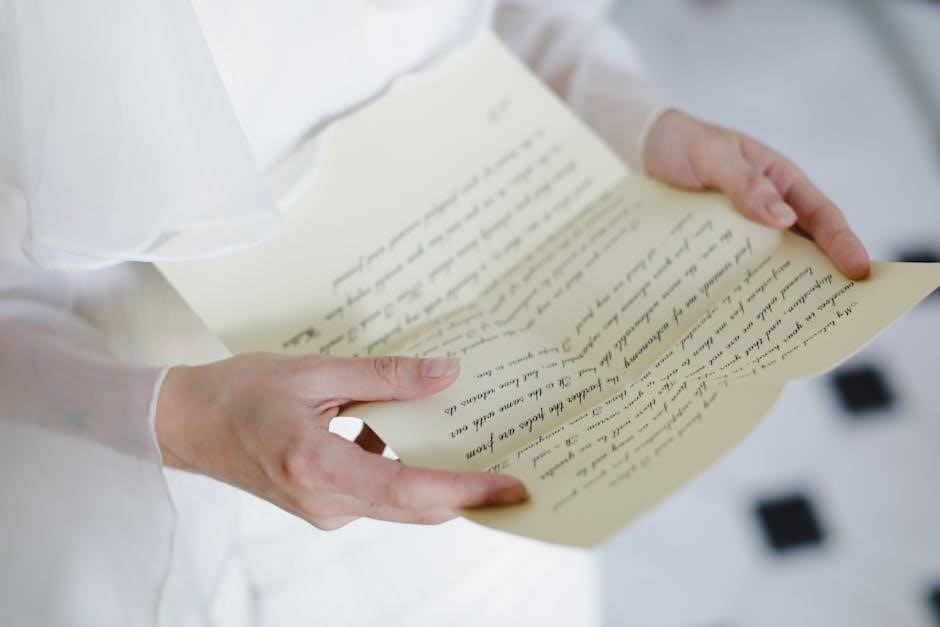A personal narrative graphic organizer is a visual tool that helps structure and guide the writing process, offering sections for hooks, setting the scene, and conclusions.
1.1 Definition of a Personal Narrative
A personal narrative is a well-told story written in a natural, honest voice about a specific occurrence in the writer’s life. It often includes vivid sensory details and emotional connections to engage readers. The narrative typically focuses on a single event or experience, allowing the writer to reflect and share insights. Personal narratives are structured to convey a clear beginning, middle, and end, making them relatable and impactful. They are commonly used in essays, letters, or memoirs, emphasizing the writer’s personal perspective and growth. Graphic organizers are often used to help structure these stories effectively, ensuring clarity and coherence in the writing process.
1.2 What is a Graphic Organizer?
A graphic organizer is a visual tool designed to help individuals structure and organize their ideas, thoughts, and information. It provides a structured format with sections or boxes that guide the user through the writing process. Graphic organizers are particularly useful for personal narratives, as they offer spaces for brainstorming, setting the scene, developing hooks, and outlining the beginning, middle, and end of a story. They are versatile and can be adapted for various writing tasks, such as essays, letters, or creative writing. The visual layout helps writers maintain focus, ensure clarity, and maintain a logical flow in their work.

Components of a Personal Narrative Graphic Organizer
A personal narrative graphic organizer typically includes sections for brainstorming ideas, setting the scene, developing a hook, and structuring the beginning, middle, and end of the story.
2.1 Brainstorming Ideas for Personal Narratives
Brainstorming is the foundation of a strong personal narrative. Graphic organizers provide dedicated spaces for students to list significant life events, emotions, and sensory details. This step encourages creativity, helping writers identify meaningful experiences and themes. By exploring memories and feelings, students can pinpoint moments that resonate, forming the core of their story. Organizers often include prompts like “What happened?” or “Who was involved?” to guide this process. This structured approach ensures ideas are captured clearly, making it easier to develop a cohesive narrative later. Effective brainstorming sets the stage for a compelling and engaging personal story.
2.2 Setting the Scene: Providing Background Information
Setting the scene in a personal narrative is crucial for helping readers visualize and connect with the story. Graphic organizers often include sections dedicated to background information, such as the time, place, and key individuals involved. Students are prompted to describe sensory details—sights, sounds, and feelings—to create a vivid mental image. This step ensures the narrative is grounded in context, making it easier for readers to engage emotionally. By breaking down the setting into manageable parts, graphic organizers guide writers in constructing a clear and immersive beginning to their story. This foundational step sets the stage for a compelling and relatable narrative.
2.3 Developing a Hook to Engage Readers
A hook is a critical element in a personal narrative, designed to capture the reader’s attention from the start. Graphic organizers often include a dedicated section for crafting a compelling hook, encouraging students to brainstorm creative openings. Examples might include a surprising statement, a thought-provoking question, or a vivid anecdote. The hook sets the tone for the story and draws readers into the narrative. By guiding students to explore various hook styles, graphic organizers help them develop an engaging introduction that effectively highlights the story’s central theme or conflict. This step ensures the narrative begins with impact, fostering reader interest and connection.

2.4 Structuring the Beginning, Middle, and End
A personal narrative graphic organizer helps students structure their story into a clear beginning, middle, and end. The beginning introduces the setting, characters, and situation, while the middle develops the plot with rising action and a climax; The end resolves the conflict and reflects on the experience. Graphic organizers often include sections for brainstorming key events, detailing the sequence of actions, and outlining the resolution. This structure ensures the narrative flows logically, maintaining reader engagement and coherence. By visually organizing these sections, students can effectively plan and execute a well-rounded personal narrative, ensuring each part contributes to the story’s overall meaning and impact.

Benefits of Using a Personal Narrative Graphic Organizer
Graphic organizers enhance writing structure, boost creativity, and improve clarity. They help students organize ideas, develop coherent narratives, and refine their writing skills effectively, supporting learning strategies.
3.1 Improved Story Structure and Organization
Using a personal narrative graphic organizer enhances story structure by providing clear sections for the beginning, middle, and end; It helps writers organize their thoughts logically, ensuring a coherent flow. With dedicated spaces for hooks, setting the scene, and conclusions, students can systematically develop their narratives. This tool is particularly effective for visual learners, as it breaks down the writing process into manageable parts. By guiding the placement of key events and details, it fosters a more organized and engaging storytelling approach, making it easier for readers to follow the narrative from start to finish.
3.2 Enhanced Creativity and Idea Generation
Personal narrative graphic organizers foster creativity by providing a structured space for brainstorming and exploring ideas. They encourage writers to think deeply about sensory details, emotions, and key events, helping to generate rich and engaging content. By visually mapping out their thoughts, students can uncover connections and themes they might not have considered otherwise. The organizer’s flexible format allows for experimentation with different story angles, making it easier to develop a compelling narrative. This tool not only sparks creativity but also helps writers maintain focus, ensuring their ideas are well-developed and effectively communicated.
3.3 Better Clarity and Coherence in Writing
Personal narrative graphic organizers enhance clarity and coherence by providing a structured format for organizing ideas. They ensure that writers include essential elements like a hook, setting, and conclusion, guiding them to present their story logically. By breaking the narrative into manageable parts, students can focus on developing each section thoroughly. The organizer also helps maintain a clear flow of events, preventing ideas from becoming disjointed. This structured approach ensures that the writer’s message is conveyed clearly, making the story easier for readers to follow and understand. The result is a more polished and cohesive personal narrative.

How to Use a Personal Narrative Graphic Organizer
Start with prewriting to brainstorm ideas, then organize main ideas and evidence. Use the organizer to craft a strong topic sentence and structure your narrative logically.
4.1 Prewriting: Generating Ideas and Details
Prewriting is the foundation of crafting a compelling personal narrative. Begin by brainstorming significant life events or experiences that evoke strong emotions or lessons learned. Use the graphic organizer to jot down key details, such as who was involved, when and where the event occurred, and how it made you feel. This stage encourages creativity and ensures that all essential elements are captured before writing begins. By focusing on sensory details and personal reflections, students can lay a solid groundwork for their narrative, making the writing process more organized and meaningful.
4.2 Organizing Main Ideas and Supporting Evidence
Organizing main ideas and supporting evidence is crucial for a coherent personal narrative. Use the graphic organizer to categorize key events, sensory details, and emotional reflections. Identify the central theme or message of your story and ensure each section supports it. Break down the narrative into clear segments, such as the introduction, rising action, climax, and resolution. Supporting evidence, like specific examples or dialogue, adds depth and authenticity. By structuring your ideas visually, you can ensure a logical flow and maintain focus, making your story more engaging and impactful for readers.
4.3 Crafting a Strong Topic Sentence
Crafting a strong topic sentence is essential for guiding the direction of your personal narrative. Use the graphic organizer to identify the central event or theme of your story. A compelling topic sentence should clearly state the main idea and set the tone for the narrative. It often includes a hook to engage readers and a brief overview of the story’s focus. The graphic organizer can help you brainstorm and refine your topic sentence, ensuring it is clear, specific, and relevant to the rest of your story. A well-crafted topic sentence will help readers understand the significance of your narrative and keep them engaged.
4.4 Writing the Conclusion and Reflection
The conclusion of a personal narrative ties together the key events and themes, providing closure and insight. Use the graphic organizer to summarize the main points and reflect on the significance of the experience. A strong conclusion should highlight what was learned or how the event impacted you. The graphic organizer can guide you in crafting reflective sentences that connect the story’s outcome to broader life lessons. Additionally, it helps ensure your reflection is thoughtful and resonates with readers, leaving a lasting impression.

Examples of Personal Narrative Graphic Organizers
Common examples include childhood memory narratives, overcoming challenges, and mentor text-based organizers, each tailored to guide students in structuring their personal stories effectively.
5.1 Childhood Memory Narrative Organizer
A childhood memory narrative organizer guides students in recounting and structuring personal stories from their youth. It typically includes sections for the topic, setting, and sensory details. Students brainstorm a specific memory, such as a family event or a significant childhood experience, and outline key moments. The organizer often features prompts to explore emotions, characters involved, and the significance of the event. This tool helps students organize their thoughts, ensuring a clear beginning, middle, and end. By focusing on vivid descriptions and personal reflections, the childhood memory organizer fosters engaging and heartfelt narratives, making it easier for young writers to convey their experiences effectively.
5.2 Overcoming Challenges Narrative Organizer
An overcoming challenges narrative organizer helps students craft stories about personal struggles and triumphs. It includes sections for the challenge, initial thoughts, actions taken, and the outcome. Students reflect on how they faced obstacles, highlighting emotions and growth. The organizer often features prompts to explore the challenge’s significance and lessons learned. By structuring the narrative into a clear beginning, middle, and end, students can effectively convey their journey. This tool encourages detailed descriptions and emotional depth, enabling writers to produce compelling and inspiring stories about resilience and personal development.
5.3 Mentor Text-Based Narrative Organizer
A mentor text-based narrative organizer uses exemplary stories to guide students in crafting personal narratives. It includes sections for analyzing the structure, tone, and techniques of the mentor text. Students identify key elements like hooks, setting, and character development, then apply these strategies to their own writing. The organizer often features prompts to connect the mentor text’s techniques to the student’s personal story. This approach enhances creativity and provides a clear framework for writing. By studying successful narratives, students learn to incorporate vivid details, emotional depth, and a strong narrative voice into their own stories, resulting in more engaging and structured personal narratives.

Importance of Graphic Organizers in Writing
Graphic organizers are essential for improving writing structure, enhancing creativity, and ensuring clarity. They provide a visual framework for organizing ideas, making the writing process more manageable and effective for all students.
6.1 Helping Students Develop Writing Skills
Graphic organizers are invaluable for fostering writing skills in students. They provide a structured framework for brainstorming, organizing, and outlining ideas, making the writing process more accessible. By breaking down narratives into components like setting, characters, and plot, students can focus on developing each element cohesively. These tools also encourage the use of sensory details and emotional connections, enhancing the depth of personal narratives. For students who struggle with writing, graphic organizers offer a clear starting point, reducing anxiety and building confidence. They cater to diverse learning styles, making abstract concepts tangible and aiding in the creation of well-structured, engaging stories.
6.2 Supporting Self-Regulated Learning Strategies
Graphic organizers play a crucial role in supporting self-regulated learning strategies by providing students with a structured framework to plan, monitor, and evaluate their writing processes. They enable students to set clear goals, break down tasks into manageable steps, and reflect on their progress. By using these tools, students develop greater control over their learning, fostering independence and accountability. The visual structure of graphic organizers helps learners identify gaps in their narratives, encouraging them to revise and refine their work. This approach empowers students to take ownership of their writing development, enhancing their ability to self-regulate and improve their storytelling skills effectively.

Digital Tools for Creating Personal Narrative Graphic Organizers
Digital tools like Canva, Google Slides, and PDF templates offer interactive and customizable options for designing personal narrative graphic organizers, enhancing creativity and accessibility for all writers.
7.1 Free PDF Templates for Personal Narratives
Free PDF templates provide structured frameworks for personal narratives, offering sections for hooks, setting, and conclusions. These templates are easily downloadable and adaptable, making them ideal for classrooms and individual use. They guide writers in organizing their ideas coherently, ensuring a logical flow from introduction to resolution. Many templates include mentor text examples, helping students understand the structure and style of effective personal narratives. Additionally, their visual layout helps students brainstorm and detail their experiences, fostering creativity and clarity in their writing. Such templates are versatile tools that cater to various learning styles, making the writing process more accessible and engaging for all.
7.2 Interactive Online Graphic Organizer Tools
Interactive online graphic organizer tools offer dynamic and engaging ways to craft personal narratives. These tools provide real-time collaboration features, allowing students to share and edit their work instantly. Many platforms include drag-and-drop options, multimedia integration, and feedback features, enhancing the writing process. They cater to diverse learning styles by offering customizable templates and visual aids. These tools also support self-paced learning, enabling students to organize their thoughts and refine their narratives effectively. With features like autosave and sharing capabilities, they streamline the writing process, making it more efficient and enjoyable for students to express their stories creatively and coherently;

Tips for Effective Use of Graphic Organizers
Use sensory details to bring stories to life and ensure emotional connections. Encourage creativity while maintaining clear structure for cohesive and engaging personal narratives.
8.1 Encouraging Detailed Sensory Descriptions
Encouraging detailed sensory descriptions in personal narratives enhances the reader’s immersion. Students should describe what they saw, heard, smelled, touched, and felt. This vivid imagery brings stories to life, making them more engaging and relatable. Graphic organizers can include specific sections for sensory details, guiding students to think critically about each sense. For example, a personal narrative graphic organizer PDF might have boxes labeled “Sights,” “Sounds,” “Smells,” “Touches,” and “Feelings.” This structured approach helps students remember to incorporate sensory elements, ensuring their narratives are rich and memorable. Teachers can also provide examples or mentor texts to demonstrate effective sensory writing.
8.2 Focusing on Emotional and Personal Connections
Focusing on emotional and personal connections is crucial for creating meaningful personal narratives. Graphic organizers provide sections for students to explore their feelings, reactions, and the emotional significance of events. This helps deepen the narrative, making it more relatable and impactful. By prompting students to reflect on their emotions, the organizer encourages authenticity and vulnerability in their writing. Teachers can use mentor texts, like An A from Miss Keller, to model how emotional connections enhance storytelling. This approach ensures students’ narratives are not just recounts of events but also expressions of personal growth and inner experiences, fostering a stronger connection with readers.
Real-World Applications of Personal Narrative Graphic Organizers
These tools are widely used in classrooms, creative workshops, and personal writing projects to help individuals structure and refine their storytelling skills effectively.
9.1 Classroom Use for Elementary Students
In elementary classrooms, personal narrative graphic organizers help young students organize their thoughts and experiences. Teachers use these tools to guide students in brainstorming ideas, setting the scene, and structuring their stories. The visual layout makes it easier for children to understand storytelling elements like beginning, middle, and end. Additionally, graphic organizers enhance creativity and provide a clear framework for writing, allowing students to focus on details and emotions. This method fosters confidence and improves writing skills, making it an essential resource for educators aiming to nurture young writers.
9.2 Use in Creative Writing Workshops
Personal narrative graphic organizers are invaluable in creative writing workshops, offering participants a structured approach to crafting compelling stories. These tools help writers brainstorm ideas, outline key events, and organize sensory details. Workshops often use PDF templates that include sections for hooks, setting, and character development. By visualizing their narratives, writers can explore emotional connections and refine their storytelling techniques. This method encourages experimentation and creativity, making it a popular choice for both experienced writers and beginners looking to refine their personal narratives. The result is more cohesive and engaging stories that resonate with readers.
Personal narrative graphic organizers are invaluable tools for structuring and enhancing storytelling, offering clarity and coherence. They empower writers to craft meaningful, engaging narratives with purpose and precision.
10.1 Summary of Key Points
Personal narrative graphic organizers are essential tools for structuring and enhancing storytelling. They help writers organize ideas, providing sections for hooks, settings, and conclusions. These organizers promote clarity, creativity, and coherence, guiding writers to craft engaging narratives. By offering a clear framework, they support students and educators in developing meaningful stories. Free PDF templates are widely available, catering to various narrative types, such as childhood memories or overcoming challenges. They also aid in teaching self-regulated learning strategies, making them invaluable in classrooms and writing workshops. Ultimately, these tools empower writers to refine their craft, fostering a deeper understanding of storytelling and its impact. They are not just about structure but about meaningful expression.
10.2 Final Thoughts on the Value of Graphic Organizers
Graphic organizers are invaluable for enhancing the writing process, particularly in personal narratives. They provide a structured yet flexible framework, empowering writers to organize ideas, explore creativity, and refine their storytelling skills. By breaking down the narrative into manageable components, these tools make writing accessible and enjoyable for students of all skill levels. The availability of free PDF templates further democratizes access, allowing educators and writers to tailor their approach. Ultimately, graphic organizers not only improve writing outcomes but also foster a deeper understanding of storytelling, making them an essential resource in both classrooms and personal writing journeys.
